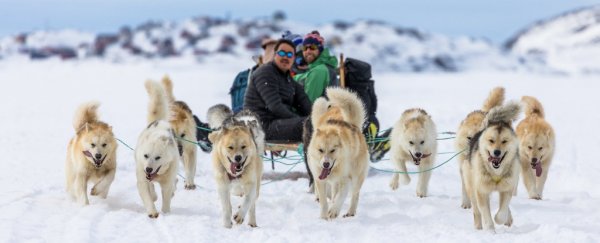In the wild and inhospitable Arctic, there's no greater companion than a dog, although not just any breed will do.
New genetic research now suggests that when the ancient Inuit migrated from Siberia to North America, all those thousands of years ago, they brought along a special group of canines to help them hunt, herd and haul their sleds.
Wherever the Inuits went, so too went their dogs, until soon, both had spread across the entire continent.
Considered one of the toughest and strongest breeds there is, this ancient Siberian canine was so indispensable, it appears the Inuit didn't even bother with any other dog - not even those already living in the region.
"Dogs have lived in North America for as long as humans," says archaeologist Carly Ameen from the University of Exeter, "but we show here that the Inuit brought new dogs to the region which were genetically distinct and physically different from earlier dogs."
And their unique genes still live on, even to this day. Comparing the genome of 922 Arctic dogs and wolves that existed in the past 4,500 years, results now suggest modern sled dogs are some of the last direct descendants of this novel Inuit breed.
Available data on such ancient creatures is admittedly limited, but the authors argue they have strong evidence human migrants brought dogs with them all the way from Siberia.
While some of these ancient genes were already present in North America beforehand, the Inuit dogs' rapid dominance and eastward expansion seems to have arrived hand-in-hand with human migration.
"Though the Inuit were likely not responsible for the first appearance of this dog lineage in the Americas, they were responsible for the considerable geographical expansion of this lineage into the Eastern Arctic, where, during the Inuit period, they became the most common haplotypes across the entire North American Arctic," the authors write.
In fact, Ameen says, after the ancient Inuit dog arrived on the continent, other native populations were almost completely replaced - and this speaks volumes about their usefulness.
Compared to native dogs in North America before the Siberian migration, Inuit dogs were probably much larger with narrower heads. Over millennia, their appearance has gradually changed, and yet even today, sled dogs are still some of the most robust and powerful canines there are.
It's not hard to guess why their ancestors were perfect for sledding, hunting, protection, clothing and, during tough times, even food.
"The usage of dogs most likely increased the speed at which they could travel, facilitating the migration across the region within a generation or two as suggested by archaeological evidence," palaeogeneticist Tatiana Feuerborn told Newsweek.
"Furthermore dog sledding on the sea ice will have also enabled them to efficiently hunt the sea mammals which they subsisted on."
Without these special canines, who knows how far the Inuit would have gotten. And without the Inuit, who knows where the Siberian dog would be now.
The study was published in Proceedings of the Royal Society B.
